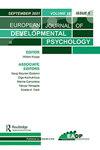From environment to genes… and back to the environment
IF 1.9
4区 心理学
Q3 PSYCHOLOGY, DEVELOPMENTAL
European Journal of Developmental Psychology
Pub Date : 2023-11-10
DOI:10.1080/17405629.2023.2277400
引用次数: 0
Abstract
ABSTRACTThis overview paper summarizes the results of studies that were conducted in the framework of two interdisciplinary, longitudinal projects of which Luc Goossens was a principal investigator: Studying the Transition to Adolescence: Testing Genes, Interactions, and Environments (STRATEGIES), and Methylation and Internalizing Problem Behaviors in Adolescence: Examining Associations Across Multiple Levels of Analysis (MIND). The main aim of these projects was to investigate to which extent genes as personal characteristics, in interaction with different environments (family, teachers and peers), can affect developmental outcomes in adolescents, such as internalizing and externalizing behaviours, loneliness, and school engagement. Different approaches were used to include genetic information, such as single nucleotide polymorphisms, polygenic scores, and methylation, and specific statistical methods were applied to combine genetic information. Although no strong conclusions could be made about GxE interactions, there is evidence for the contribution of parents, teachers and peers (in the development) of adolescent behaviours and emotions, but genes also appear to play a role.KEYWORDS: Gene x environmentmethylationinternalizing and externalizing problemslonelinessschool engagement Disclosure statementNo potential conflict of interest was reported by the author(s).Data availablitity of statementData sharing is not applicable to this article as no new data were created or analyzed in this study.Additional informationFundingThis work was supported by the KU Leuven Internal funding [C14/16/040].从环境到基因,再回到环境
摘要本文综述了Luc Goossens担任首席研究员的两个跨学科纵向项目的研究成果:研究青少年过渡:测试基因、相互作用和环境(策略),以及青少年问题行为的甲基化和内化:检查跨多层次分析(MIND)的关联。这些项目的主要目的是调查基因作为个人特征,在与不同环境(家庭、教师和同伴)的相互作用中,可以在多大程度上影响青少年的发展结果,如内化和外化行为、孤独感和学校参与。采用不同的方法来包含遗传信息,如单核苷酸多态性、多基因评分和甲基化,并采用特定的统计方法来组合遗传信息。虽然对GxE的相互作用没有强有力的结论,但有证据表明父母、老师和同伴(在发展过程中)对青少年的行为和情绪做出了贡献,但基因似乎也发挥了作用。关键词:基因x环境甲基化内在化和外在化问题孤独学校参与披露声明作者未报告潜在的利益冲突。数据共享不适用于本文,因为本研究没有创建或分析新的数据。本研究由鲁汶大学内部基金支持[C14/16/040]。
本文章由计算机程序翻译,如有差异,请以英文原文为准。
求助全文
约1分钟内获得全文
求助全文
来源期刊

European Journal of Developmental Psychology
PSYCHOLOGY, DEVELOPMENTAL-
CiteScore
3.70
自引率
0.00%
发文量
35
 求助内容:
求助内容: 应助结果提醒方式:
应助结果提醒方式:


